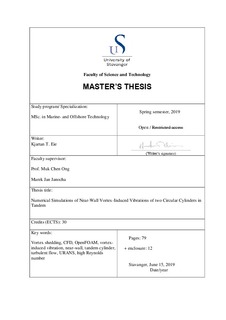| dc.description.abstract | Free-spanning subsea pipelines may experience vortex-induced vibrations (VIV) when exposed to fluid flow. These resonant motions can cause fatigue-related problems and in some cases failure of the pipe. A common configuration is to have two pipelines laid next to each other. This further complicates the dynamic response, as the downstream pipeline is affected by the flow-interference induced by the upstream pipe. Two cylinders in tandem arrangement in the vicinity of a horizontal plane wall have been investigated numerically using 2D Unsteady Reynolds-Averaged Navier-Stokes (URANS) equations with a k-ω SST turbulence model. The cylinders are modelled as elastically supported with two-degrees-of-freedom (2DoF) which allow for both transverse and inline vibrations. Based on the cylinder diameter, D, the Reynolds number investigated in the present study is Re=3.6×10^6, corresponding to the transcritical flow regime. The effects of three main parameters are investigated; (i) gap ratio, G^*, is the gap distance from the horizontal boundary to the cylinder surface, (ii) cylinder spacing, L^*, is the horizontal surface-to-surface distance of the tandem cylinders (iii) reduced velocity, U_r, is the ratio of flow velocity to vibration frequency and diameter. Numerical simulations are performed for 〖U_r={4,5},G〗^*={1.5,2},L^*={4,5,6} using the open source CFD code OpenFOAM. The mass ratio is set to m^*=10, damping ratio to ζ=0, and boundary layer thickness δ/D=0.48. The model is validated against similar published studies. The single static cylinder model is in a good agreement with similar numerical studies. The model is modified to include a second downstream cylinder and allow for 2DoF vibrations. A second mesh sensitivity study is performed to determine the appropriate mesh density for the tandem case. Hydrodynamic forces, response amplitudes, motion trajectories, flow fields and frequency power spectra for displacements and hydrodynamic coefficients are analyzed and presented with respect to the parameter matrix defined in the study. | nb_NO |
